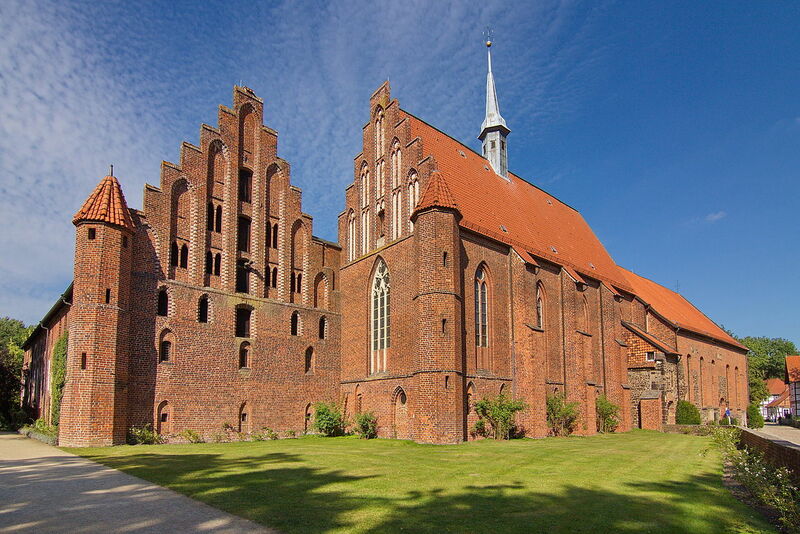Wienhausen Abbey
Type:
Churches,
Illuminated manuscripts,
Monasteries,
Sarcophagi,
Sculptures,
Stained-glass windows,
Textiles,
Wall paintings
Date:
ca. 1290 (Christ sculptures),
1330 (rebuilding and repainting),
1448 (painted sarcophagus)
Location or Findspot (Modern-Day Country):
Germany
Description:
The convent founded at Wienhausen in 1266 is still in use today, although the nuns no longer follows Cistercian customs. Its founder, Agnes, had obtained a miracle-working relic of the blood of Jesus that attracted pious donations, and Wienhausen became quite wealthy. The convent was rebuilt in brick around 1330 and the most important spaces were redecorated at that time. These are on the south in the plan: the vaulted nuns' choir, where they sang during services (from which they were physically removed), and the adjacent church. Other monastic buildings surround the central cloister and cemetery.
The nuns "married" Christ when they joined the convent, and images of Jesus are prominent in stained glass, wall paintings, and sculptures. A polychromed wood statue of Christ rising from his tomb dates to about 1290; it may have served as a retable. The large, drilled wound in Christ's side was a compelling focus. Another, contemporary effigy of Jesus lay in a painted wood sarcophagus donated by Abbess Katharina von Hoya in 1448. Small doors at each end allowed the women to touch or kiss the head and feet of the dead Christ. Life-size replicas or evocations of the sepulcher of Christ were popular from the late thirteenth century onward; they played a role in reenactments of the Passion that took place at Easter. Oily residue on the effigy of Jesus shows that the nuns anointed the carved body, much as the Marys planned to do at the tomb in Jerusalem before they found it empty (Mark 16:1, Luke 24:1).
The Wienhausen nuns produced high-quality embroideries, some with secular subjects, such as the love story of Tristan and Isolde. They also made clothing for all of the sculptures of Christ, from doll-size to life-size, and these garments were stiffened with recycled pages from books. A trove of clothing, manuscript pages, devotional pictures, relics, tools for reading and writing, and some mysterious objects—over 2,000 items in all—was found under the floor of the nuns' choir in the 1950s and is still being studied.
The nuns "married" Christ when they joined the convent, and images of Jesus are prominent in stained glass, wall paintings, and sculptures. A polychromed wood statue of Christ rising from his tomb dates to about 1290; it may have served as a retable. The large, drilled wound in Christ's side was a compelling focus. Another, contemporary effigy of Jesus lay in a painted wood sarcophagus donated by Abbess Katharina von Hoya in 1448. Small doors at each end allowed the women to touch or kiss the head and feet of the dead Christ. Life-size replicas or evocations of the sepulcher of Christ were popular from the late thirteenth century onward; they played a role in reenactments of the Passion that took place at Easter. Oily residue on the effigy of Jesus shows that the nuns anointed the carved body, much as the Marys planned to do at the tomb in Jerusalem before they found it empty (Mark 16:1, Luke 24:1).
The Wienhausen nuns produced high-quality embroideries, some with secular subjects, such as the love story of Tristan and Isolde. They also made clothing for all of the sculptures of Christ, from doll-size to life-size, and these garments were stiffened with recycled pages from books. A trove of clothing, manuscript pages, devotional pictures, relics, tools for reading and writing, and some mysterious objects—over 2,000 items in all—was found under the floor of the nuns' choir in the 1950s and is still being studied.
Relevant Textbook Chapter(s):
10
Repository and Online Resources:
• Listen to an illustrated lecture about the finds from under the nuns' choir by Prof. Henrike Lähnemann, "Nuns' Dust: The Materiality of Northern German Devotional Production" here.
• See Wienhausen's works of art on the Kornbluth Photography website.
• Listen to an illustrated lecture about the finds from under the nuns' choir by Prof. Henrike Lähnemann, "Recycled Parchment: Manuscript Fragments from Medieval Dresses."
Image Credits:
Navid Jamali; Wikimedia Commons,


